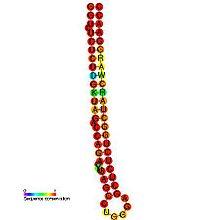| Trans-activation response element (TAR) | |
|---|---|
 Predicted secondary structure and sequence conservation of mir-TAR | |
| Identifiers | |
| Symbol | mir-TAR |
| Alt. Symbols | TAR |
| Rfam | RF00250 |
| Other data | |
| RNA type | Gene; miRNA |
| Domain(s) | Viruses |
| GO | GO:0035068 GO:0035195 |
| SO | SO:0000233 SO:0001244 |
| PDB structures | PDBe |
The HIV trans-activation response (TAR) element is an RNA element which is known to be required for the trans-activation of the viral promoter and for virus replication. The TAR hairpin is a dynamic structure[1] that acts as a binding site for the Tat protein, and this interaction stimulates the activity of the long terminal repeat promoter.[2]
Further analysis has shown that TAR is a pre-microRNA that produces mature microRNAs from both strands of the TAR stem-loop.[3] These miRNAs are thought to prevent infected cells from undergoing apoptosis by downregulating the genes ERCC1, IER3,[4] CDK9, and Bim.[5]
References
- ^ Lu, Jia; Kadakkuzha, Beena M.; Zhao, Liang; et al. (2011). "Dynamic Ensemble View of the Conformational Landscape of HIV-1 TAR RNA and Allosteric Recognition". Biochemistry. 50 (22): 5042–5057. doi:10.1021/bi200495d. PMID 21553929.
- ^ Kulinski, T; Olejniczak M; Huthoff H; Bielecki L; Pachulska-Wieczorek K; Das AT; Berkhout B; Adamiak RW (2003). "The apical loop of the HIV-1 TAR RNA hairpin is stabilized by a cross-loop base pair". J Biol Chem. 278 (40): 38892–38901. doi:10.1074/jbc.M301939200. PMID 12882959.
- ^ Ouellet DL, Plante I, Landry P, et al. (April 2008). "Identification of functional microRNAs released through asymmetrical processing of HIV-1 TAR element". Nucleic Acids Res. 36 (7): 2353–2365. doi:10.1093/nar/gkn076. PMC 2367715. PMID 18299284.
- ^ Klase Z, Winograd R, Davis J, et al. (2009). "HIV-1 TAR miRNA protects against apoptosis by altering cellular gene expression". Retrovirology. 6: 18. doi:10.1186/1742-4690-6-18. PMC 2654423. PMID 19220914.
- ^ Narayanan, A; Iordanskiy, S; Das, R; Van Duyne, R; Santos, S; Jaworski, E; Guendel, I; Sampey, G; Dalby, E; Iglesias-Ussel, M; Popratiloff, A; Hakami, R; Kehn-Hall, K; Young, M; Subra, C; Gilbert, C; Bailey, C; Romerio, F; Kashanchi, F (5 July 2013). "Exosomes derived from HIV-1-infected cells contain trans-activation response element RNA". The Journal of Biological Chemistry. 288 (27): 20014–20033. doi:10.1074/jbc.m112.438895. PMC 3707700. PMID 23661700.